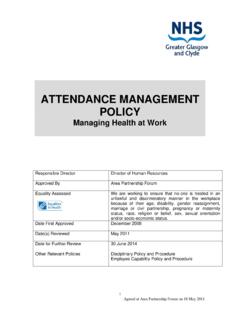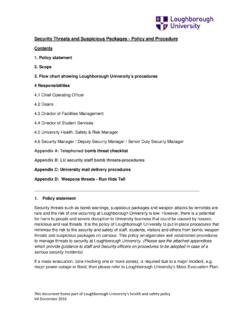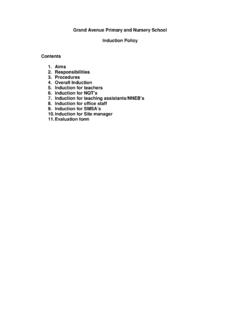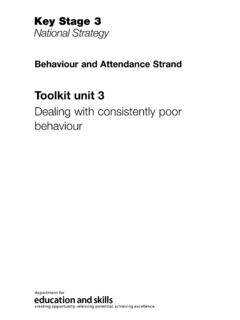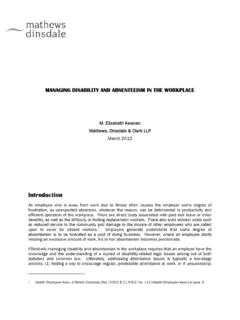Transcription of Writing Effective Policies - ePolicy Institute
1 White Paper Writing Effective Policies Using Written policy to Manage Behavior, Mitigate Risks, & Maximize Compliance Written By: Nancy Flynn The ePolicy Institute 2011, Nancy Flynn, The ePolicy Institute and Prevalent Networks, LLC. Founder & Executive Director, The ePolicy Institute Author, Handbook of Social Media (2011), The ePolicy Toolkit (2011), The e- policy Handbook, E-Mail Rules, Instant Messaging Rules, Blog Rules, Writing Effective E-Mail, E- Mail Management, and other books Page 1 Confidential 4/20/11. Overview Prevalent Networks, and The ePolicy Institute , , have created Writing Effective Policies : Using Written policy to Manage Behavior, Mitigate Risks & Maximize Compliance, a best practices-based business guide for human resource professionals, legal and compliance officers, training managers, IT. decision-makers, information security managers, business owners, and anyone who plays a role in Writing , implementing, and managing workplace Policies .
2 Through the implementation of a strategic policy management program, incorporating clear and comprehensive written Policies , formal employee education, and a proven- Effective policy management solution, organizations successfully can manage their legal, regulatory, and organizational risks and compliance obligations. Writing Effective Policies : Using Written policy to Manage Behavior, Mitigate Risks &. Maximize Compliance is produced as a general best-practices guide with the understanding that neither the author, ePolicy Institute Founder & Executive Director Nancy Flynn, nor the publisher, Prevalent, is engaged in rendering advice on legal, regulatory, or other issues. Before acting on any policy or procedure addressed in this whitepaper, you should consult with legal counsel or other professionals competent to review the relevant issue. Page 2 Confidential 4/20/11. Introduction: Why Every Organization Needs Effective Written Policies Regardless of whether your enterprise is public or private, large or small, for-profit or not-for- profit, regulated or unregulated, all organizations need effectively written and strategically managed business Policies .
3 Effective written Policies communicate organizational, legal, and regulatory rules to full- and part- time employees, executives and board members, independent contractors and consultants, and others working on behalf of your organization. Effective written Policies provide employees with a clear understanding of what constitutes appropriate, acceptable, and lawful business behavior. Effective written Policies help employers demonstrate to courts and regulators, employees and applicants, customers and investors, the media and decision-makers, and other important audiences that the organization is committed to operating a business environment that is civil, compliant, and correct. Through the strategic implementation of a business policy program that combines written rules with employee education supported by policy management tools, employers in all industries and professions can minimize (and in some cases prevent) potentially costly and protracted risks, while mandating appropriate business behavior, and maximizing compliance with legal, regulatory, and organizational guidelines.
4 Three-Step Formula for policy - Writing Success Regardless of your comfort, skill, or experience as a business writer, you can improve the quality of your policy Writing , enhance the effectiveness of your written rules, and magnify the success of your compliance management program simply by applying this three-step formula for policy - Writing success: Step 1. Pre- Writing : Conduct a policy audit. Step 2. Writing : Create well-written Policies . Step 3. Post- Writing : Manage policy compliance. Page 3 Confidential 4/20/11. I. PRE- Writing BEST PRACTICE: CONDUCT A policy AUDIT. Before you start Writing or revising Policies , first take a clear-eyed look at your current business Policies from a legal, regulatory, and organizational standpoint. In other words, conduct a formal audit of your existing policy program. Understandably, you will need to create separate audit questionnaires and undertake separate audits for nearly every business policy you plan to write or revise.
5 After all, the legal, regulatory, and organizational risks and rules that should be addressed in an email policy are entirely different from those of a corporate vacation policy . Best practices call for: (A) One free-standing audit per policy ; and (B) One stand-alone policy per technology (email), situation (vacation), or behavior (harassment & discrimination) that you seek to manage through formal rules. While the nature of your Policies will determine the exact content of your audit questionnaires, in general you'll want to uncover the following types of information in the course of a workplace policy audit: 1. policy audience and goals: Who is the intended audience for this policy ? Why does this particular situation/behavior/technology merit formal rules? What does the organization hope to accomplish with this policy ? Is there a proven need for this policy ? What benefits will this policy deliver to the organization and its employees? Are employees likely to respond positively or negatively to this policy ?
6 2. Review policy -related legal and regulatory risks and rules. Assign your legal counsel or compliance officer the task of reviewing current federal/state laws and government/industry regulations governing the situation/behavior/technology addressed by the policy in question. Determine exactly what your organization needs to do from the standpoint of policy , training, and management technology to achieve legal and regulatory compliance on the federal level and in all states in which you do business, have customers, or litigate lawsuits. Laws and regulatory requirements vary by jurisdiction and industry, so it is essential for you to do your homework before Writing policy . For example, Social Media policy , Email policy , and Text Messaging policy would all be written in the context of monitoring laws, e-discovery rules, and electronic record retention guidelines set forth by federal and state courts. Similarly, if your company handles private consumer information including Social Security and credit card numbers, then your Confidentiality policy may need to address Data Breach Notification Law, the Gramm-Leach-Bliley Act, PCI-DSS, and State Encryption Law.
7 Page 4 Confidential 4/20/11. 3. Review policy -related organizational risks facing your company and employees. Has excessive absenteeism led to a slide in workplace productivity? Have you been forced to terminate otherwise valuable employees because of inappropriate computer use? Has offensive behavior by managers triggered hostile work environment or harassment claims by staff? Has inconsistent policy enforcement led to resentment among employees? If your focus is on the creation of Effective electronic Policies , then you'll need to evaluate the ways in which your organization accesses and uses email, the Web, and other electronic business communication tools and technologies. Do you provide employees with Smartphones? Do employees use IM, text messaging, or mobile devices for internal/external communications? Do you retain and archive email and other forms of electronically stored information? Do you allow personal use of the company email system?
8 Are employees allowed to access private email accounts, visit non-business-related Web sites, or post personal Tweets during the workday? 4. In the age of social media, many organizations are adopting Policies to manage Facebook, YouTube, Twitter, LinkedIn, and other networking sites. If you're embarking on a Social Media policy , be sure to research employees' after-hours social media use in the course of your policy audit. Are employees using personal blogs and social networking sites to comment on your business? Do employees go online after hours to whine or complain about their jobs? Have employees accidentally or intentionally leaked confidential business or consumer information that could damage the organization's reputation, trigger a lawsuit, or jumpstart a regulatory investigation? 5. Take a close look at all of your organization's existing business Policies . Do you have in place separate Policies governing all technologies (email, Internet, text messaging, blogs, mobile devices, etc.)
9 , situations (vacation, attendance, dress code, etc.), and behaviors (harassment & discrimination, ethics, code of conduct, etc.)? When is the last time your company updated its Policies ? 6. Are your current Policies well-written? Are they easy to read, understand, and adhere to? Do you have a skilled business writer on staff to write and revise Policies , or will you need to retain the services of a freelance policy writer to produce Effective Policies ? 7. Are your Policies well-designed and visually appealing? Does the look of your Policies enhance their readability? Do you employ an in-house designer who is adept at producing readable, visually appealing Policies ? Or will you need to hire a freelance designer to handle policy design and production? 8. How do you distribute Policies to employees? Best practices call for policy distribution in the course of formal employee training. Yet, most employers rely solely on the employee handbook or Intranet to introduce Policies to workers, Page 5 Confidential 4/20/11.
10 According to American Management Association/ ePolicy Institute research. policy distribution is critical. There's no point Writing Policies if no one knows they exist. 9. The results of your policy audit will help you identify and understand the specific risks facing your organization. Based on your audit findings, you are now ready to update old Policies and, as necessary, create new Policies for 2011. 10. Be sure to date each new and revised policy before putting it into circulation. Collect and destroy all but one file copy of your old Policies . Make sure every employee receives or has access to one copy of each new and revised policy . 11. Repeat the policy audit process annually. II. BEST PRACTICES FOR Writing Effective Policies . Use Clear & Specific Language Whether you are creating Policies governing attendance and dress, ethics and conduct, text messaging and mobile devices, or data security and confidentiality, Effective written Policies should incorporate clear and specific language that is not open to interpretation by individual employees.




